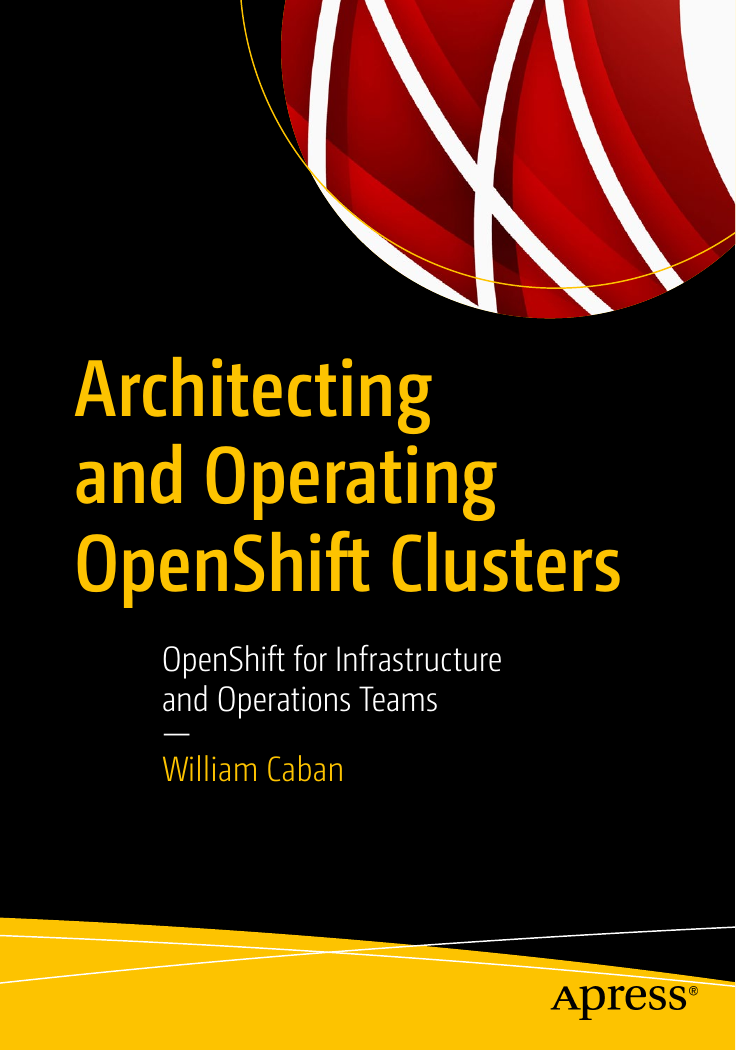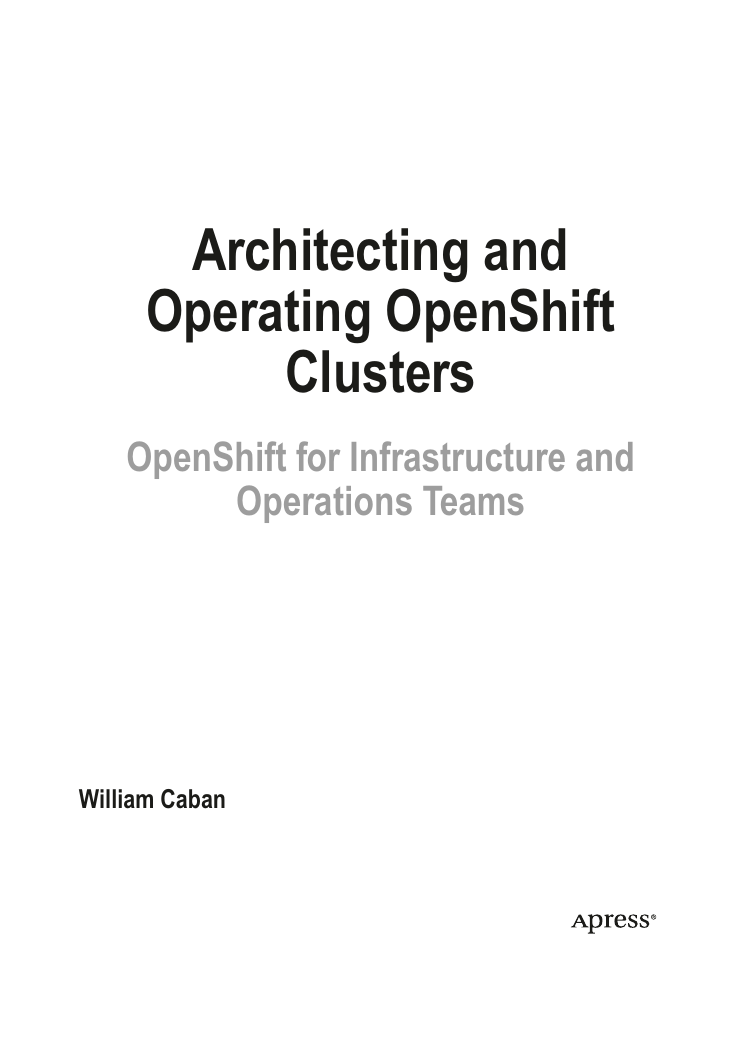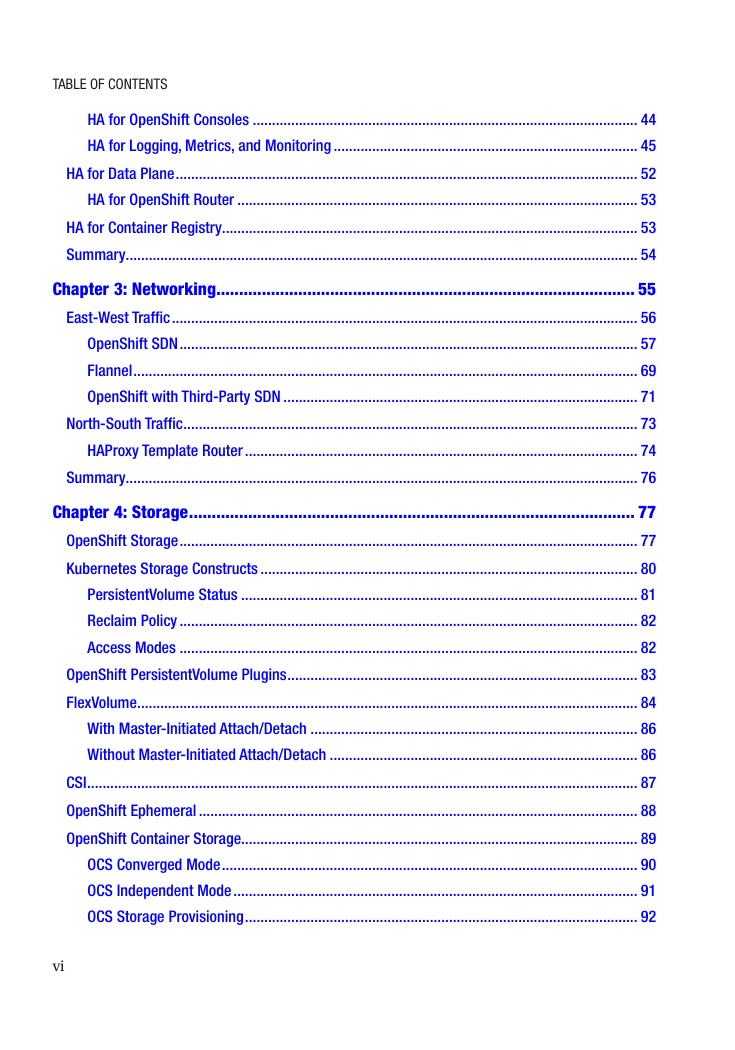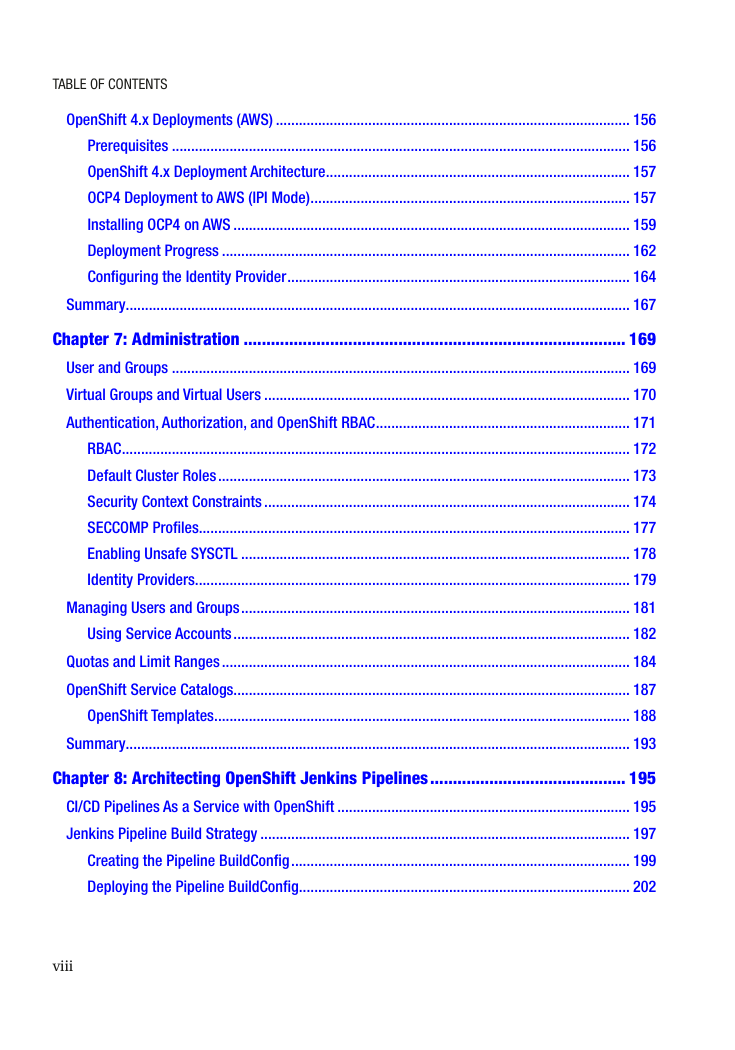Table of Contents
About the Author
About the Technical Reviewer
Acknowledgments
Introduction
Chapter 1: The OpenShift Architecture
Linux Containers
Linux Container: Under the Hood
Container Specifications
Container Runtime and Kubernetes
Introduction to OpenShift Architecture Components
Kubernetes Constructs
OpenShift Constructs
Master Nodes
Infrastructure Nodes
App Nodes
OpenShift Consoles
OpenShift Routers
OpenShift Registry
Summary
Chapter 2: High Availability
Control Plane and Data Plane
HA for Control Plane
HA for ETCD
RAFT Consensus Algorithm
HA for Master Services
HA for OpenShift Consoles
HA for Logging, Metrics, and Monitoring
OpenShift Monitoring
Metrics
Metrics Server
Logging
HA for Data Plane
HA for OpenShift Router
HA for Container Registry
Summary
Chapter 3: Networking
East-West Traffic
OpenShift SDN
OpenShift ovs-subnet
OpenShift ovs-multitenant
OpenShift ovs-networkpolicy
Flannel
OpenShift with Third-Party SDN
OpenShift with Calico SDN
North-South Traffic
HAProxy Template Router
Summary
Chapter 4: Storage
OpenShift Storage
Kubernetes Storage Constructs
PersistentVolume Status
Reclaim Policy
Access Modes
OpenShift PersistentVolume Plugins
FlexVolume
With Master-Initiated Attach/Detach
Without Master-Initiated Attach/Detach
CSI
OpenShift Ephemeral
OpenShift Container Storage
OCS Converged Mode
Raw Disks for OCS Converged Mode
OCS Independent Mode
OCS Storage Provisioning
Storage Classes
OpenShift with Third-Party Storage
DriveScale Composable Platform
HPE 3PAR
HPE Nimble
NetApp Trident
OpenEBS (OSS, MayaData)
Summary
Chapter 5: Load Balancers
Load Balancer Overview
Load Balancer Considerations
Considerations for Master Nodes
Considerations for Infrastructure Nodes
Considerations for Specialized Protocols
Summary
Chapter 6: Deployment Architectures
Minishift
OCP 3.11 Deployment Architectures
Prerequisites
Operating System—Minimal Installation
General Requirements for the Cluster
SDN Subnets
(Optional) Subnets for Hosting Apps with Non-Web-Based or Specialized Protocols
Registry Service Account and Token
Activate and Assign OpenShift Subscriptions
Prepare OCP 3.11.x Installer on Bastion
Enable Password-less SSH
OpenShift Ansible Inventory File
Defining the OpenShift Release
Registry Definitions and Access
Red Hat OpenShift Container Storage
Web Console Access and Wildcard Apps Domain
Audit Logs
Configuring the SDN
Identity Providers
Cluster Monitoring (Prometheus)
Cluster Metrics (EFK Stack) and Logging
OpenShift Router and OpenShift Container Registry
OpenShift Service Catalog and Service Brokers
OpenShift Nodes
Sample Deployment Scenarios
Single Node Deployment (All-in-One)
Non-HA Control Plane Deployment
Full-HA Control Plane Deployment
Deploying OpenShift
Uninstalling OpenShift
Bastion Node as Admin Jumphost
OpenShift 4.x Deployments (AWS)
Prerequisites
OpenShift 4.x Deployment Architecture
OCP4 Deployment to AWS (IPI Mode)
Installing OCP4 on AWS
Standard Deployment
Customizing Standard Deployment
Deployment Progress
Configuring the Identity Provider
Summary
Chapter 7: Administration
User and Groups
Virtual Groups and Virtual Users
Authentication, Authorization, and OpenShift RBAC
RBAC
Default Cluster Roles
Security Context Constraints
SECCOMP Profiles
Enabling Unsafe SYSCTL
Identity Providers
Managing Users and Groups
Using Service Accounts
Quotas and Limit Ranges
OpenShift Service Catalogs
OpenShift Templates
Summary
Chapter 8: Architecting OpenShift Jenkins Pipelines
CI/CD Pipelines As a Service with OpenShift
Jenkins Pipeline Build Strategy
Creating the Pipeline BuildConfig
Deploying the Pipeline BuildConfig
Jenkinsfile with Source Code
Multiproject Pipelines
OpenShift Client Plugin
Custom Jenkins Images
Integrating External CI/CD Pipelines
Summary
Chapter 9: Day-2 Operations
Managing Leftover Objects
Garbage Collection
Node Optimizations
Node Resource Allocation
Setting Max Pods Per Node
Using the Tuned Profile
Eviction Policy
Pod Scheduling
Pod Priority
Summary
Chapter 10: Advanced Network Operations
Network Optimizations
Jumbo Frames and VXLAN Acceleration
Tuning Network Devices
Routing Optimizations
Route-Specific Optimizations Annotations
IP Whitelists
OpenShift Router Sharding
Supporting Non-HTTP/HTTPS/TLS Applications
Using IngressIP and ExternalIP
Using NodePorts and HostPorts
Multiple NIC per POD
OpenShift ServiceMesh
Summary
Chapter 11: OCP 4.1 UPI Mode Bare-Metal with PXE Boot Deployment
UPI Mode
Bare-Metal with PXE Boot Example
UPI Bare-Metal with PXE Boot
Prerequisites
DNS Configuration (Example)
Load Balancer Configuration (Examples)
DHCP with PXE Boot Configuration (Example)
PXE Boot Configuration (Example)
Preparing the Installation
Considerations with UPI Mode with PXE Boot
Downloading RHCOS and Installation Binaries
Preparing the PXE Boot Images
Installation
Creating the Configuration
Generating the Ignition Files
Bootstrap and Master Nodes
Worker Nodes
Summary
Index
















 2023年江西萍乡中考道德与法治真题及答案.doc
2023年江西萍乡中考道德与法治真题及答案.doc 2012年重庆南川中考生物真题及答案.doc
2012年重庆南川中考生物真题及答案.doc 2013年江西师范大学地理学综合及文艺理论基础考研真题.doc
2013年江西师范大学地理学综合及文艺理论基础考研真题.doc 2020年四川甘孜小升初语文真题及答案I卷.doc
2020年四川甘孜小升初语文真题及答案I卷.doc 2020年注册岩土工程师专业基础考试真题及答案.doc
2020年注册岩土工程师专业基础考试真题及答案.doc 2023-2024学年福建省厦门市九年级上学期数学月考试题及答案.doc
2023-2024学年福建省厦门市九年级上学期数学月考试题及答案.doc 2021-2022学年辽宁省沈阳市大东区九年级上学期语文期末试题及答案.doc
2021-2022学年辽宁省沈阳市大东区九年级上学期语文期末试题及答案.doc 2022-2023学年北京东城区初三第一学期物理期末试卷及答案.doc
2022-2023学年北京东城区初三第一学期物理期末试卷及答案.doc 2018上半年江西教师资格初中地理学科知识与教学能力真题及答案.doc
2018上半年江西教师资格初中地理学科知识与教学能力真题及答案.doc 2012年河北国家公务员申论考试真题及答案-省级.doc
2012年河北国家公务员申论考试真题及答案-省级.doc 2020-2021学年江苏省扬州市江都区邵樊片九年级上学期数学第一次质量检测试题及答案.doc
2020-2021学年江苏省扬州市江都区邵樊片九年级上学期数学第一次质量检测试题及答案.doc 2022下半年黑龙江教师资格证中学综合素质真题及答案.doc
2022下半年黑龙江教师资格证中学综合素质真题及答案.doc